
Motion Camouflage and Spinning Wheels PDF
Preview Motion Camouflage and Spinning Wheels
MISCELLANEOUS NOTES ACKNOWLEDGEMENTS largergonadsthanmaleswithlargeenergyricheggs,whereas males have much smaller gonads that produce numerous relatively inexpensive sperm. WearegratefultoRev.Fr.JoseChunkan(CMI),Principal, Thisstudyhasfocusedontheultimateexplanationsof Christ College, Irinjalakuda, forproviding all facilities for the the observed sexual dimorphism inS. argus, yetitwouldbe study. The second author is also grateful to University Grants interesting to furtherexamine the proximate causesofthese CommissionforprovidingResearchFellowshipduringthetenure ofwhichthepresentworkwascarriedout. differences. Andersson, M. (1994): Sexual selection. Princeton, NJ: Pub. by perch,Priacanthushamrur(Cuv. &Val.).J. BombayNat. Hist. PrincetonUniversity Press^NewJersey.447pp. Soc. 95(1): 132-134. HoneySebastian,N.D.Inasu&C.O.Joshi(2005):Sexualdimorphism Rf.imchen,T.E. & P. Nosil (2004): Variable predation regimes predict in the Silver Belly Leiognathus brevirostris (Valenciennes). theevolutionofsexualdimorphisminapopulationofthreespine J. Mar. Biol.Ass. India47(2): 213-214. stickleback. Evolution 58(<5):1274-1281. Inasu, N.D. (1993): Sexual dimorphism of a fresh water puffer fish Talwar, P.K. & A.G. Jhingran (1991): Inland fishes of India and TetraodoniravancoricusHoraandNair,collectedfromTrichur Adjacent countries, Oxford & IBH publishing company. district,central Kerala.J. BombayNat. Hist. Soc. 90: 523-524. NewDelhi. 878pp. KurianMolly&N.D. Inasu(1997):Sexualdimorphismoftwoinland Thobias,M.P(1974):Observationsonthemorphologicalvariationsin edible catfishes Ompok bimaculatus (Bloch) and Horabagrus Puntius filamentosus (Val.) Family Cyprinidae: with a brachysoma (Gunther).J. Inlandfish. Soc. India29(2): 34-39. redescription of the species. J. Inland fish. Soc. India MandyTessy J. & N.D. Inasu (1998): Sexual dimorphism ofmarine 6: 45-50. MOTION CAMOUFLAGEAND SPINNING WHEELS 15. PeterSmetacek1 'JonesEstate,Bhimtal,Nainital 263 136,Uttarakhand,India. Email: [email protected],[email protected] Acharya (1961) and Worth (1962) noted the strange dragonfliesarefunlovingandconstantlysportwitheachother. behaviour of dragonflies in relation to spinning bicycle “Perhaps the habit of continuous movement may be wheels. Acharya (1961) noted that near a particular lake in responsibleforthepeculiarbehaviourreferredtoabove,being Gujarat, up to 50 dragonflies of an undetermined species attracted by the moving wheels.” belongingtoAnisopterawouldflyparallelwiththerearwheel Worth (1962) suggested that dragonflies use hunting ofhisbicycle,movingwhenhemovedandstoppingwhenhe tacticssimilartothoseusedbyCattleEgrets,whoattendlarge stopped. They would maintain their fixed position even in mammals in order to catch the insects disturbed and put to response to aburstofspeed orsudden slowing. flightby these mammals. Worth (1962) noted that SouthAfrican dragonflies of Mizutanietal. (2003)throwmorelightonthismatter. the same suborder also maintained a constant position with Theysuggestthatdragonfliesutilizemotioncamouflage as respect to the spinning front wheel of his bicycle. He also a means ofcatching highly manoeuvrable prey. In this, the mentionedthatthedragonflieswouldkeeppacewithhisfeet dragonflymovesinsuchawaythatitimitatesthetrajectory when he walked along sunny trails. of a distant stationary object on the retina of its potential I have on a few occasions had the same thing happen preybymaintainingacertainpositioninrelationtotheretina with the large dragonflyAnaxguttatus (Burmeister) and the of the potential prey. This is achieved by precise flight front wheel of my motorcycle, moving at 30 kmph in the control and positional sensing. That is if Acharya’s and BhimtalvalleyinUttarakhand.Once,oneofthesedragonflies Worth’s rear and front wheels respectively or my accompanied meforabout200monawindinghillroad. On motorcycle’s front wheel had retinas, they would have another occasion I noticed the dragonfly by the flashing observedastationarydragonflywhilewe, theriders,witha reflections of the evening sun off its wings, which looked differenttrajectory,noticedandwonderedaboutthemoving verymuchlikethelightreflectedfromthespokesofspinning dragonflies practising their inborn, so far unexplained, motorcycle or, indeed, bicycle wheels. abilitytoappearmotionlessand, therefore,harmless,tothe Both of the previous authors could not offer a spinning wheels. satisfactory explanation. Acharya (1961) suggested that This,then,isarathercleverwayofstalkingprey.This J. Bombay Nat. Hist. Soc., 105 (3), Sep-Dec 2008 351 MISCELLANEOUS NOTES impliesthatthedragonfliesconsideredthespinning wheels are activeevenatdusk,thiscouldbeapreliminarymeansof as something worth stalkingor, atleast, pursuing. In oneof materecognition. my experiences, the reflections from the transparent wings ACKNOWLEDGEMENT of the accompanying Anax dragonfly reminded me very much of a spinning wheel. Perhaps1the flashes of light reflected from the spinning spokes resemble a dragonfly’s I am grateful to Dr. Arun Kumar of the Zoological wings’ flashes on the retina ofthe stalking dragonfly. SurveyofIndia, Dehradun,forkindly supplyingthenameof In the case ofthe large, solitaryAnax species, which the authorofAnaxguttatus. REFE Acharya. H.G. (1961): Strange behaviour of some dragonflies. indragonflies.Nature423: 604. J. BombayNat. Hist. Soc. 58: 819-820. Worth, C.B. (1962): Dragonflies and bicycles. J. Bombay Nat. Hist. Mizutani,A.,J.S.Chahl&M.V.Srintvasan(2003):Motioncamouflage Soc. 59: 676-677. 16. ABUNDANCEAND DIVERSITY OF ODONATA (INSECTA) IN SOME HILLY REGIONS OFTAMIL NADU R. Arulprakash1-2and K. Gunathilagaraj1 'DepartmentofAgriculturalEntomology,TamilNaduAgriculturalUniversity,Coimbatore641 003,TamilNadu,India. ’Email [email protected] : Introduction ht.). InYercaud, collections were made from small streams, Fraser (1933, 1934, 1936) recorded 116 species of tributaries of Kiliyanur River and from boat house lake. Odonata (Insecta) from the hilly regions ofIndia. Aperusal Karunkaradu, Pallikaradu, Periakaradu and Poonaikundru ofliterature (Miller 1992; Gunathilagaraj etal. 1999; Palot were devoid of water bodies and collections were made andSoniya2000a,b;AsaithambiandManickavasagam2002; with a sweep net by slowly walking around the hills. EmiliyammaandRadhakrishnan2003;Kandibaneetal.2005; The identity ofcollected Odonata was fixed using the keys Sharma et al. 2007) showed that there has been no developedbyFraser(1933, 1934, 1936), KumarandPrasad comprehensive study on the abundance and diversity ofthis (1981), Ram et al. (1982), Barrion and Litsinger (1994), groupfromthehillyregionsofTamilNadu.Hence,thepresent and Emiliyamma and Radhakrishnan (2000). Odonata study was conducted to assess the diversity and abundance diversity was computed using the Simpson’s index of Odonata in five hilly regions of Salem district in Tamil (Simpson 1949). Nadu. s Simpson’s index (Z) = X ni (ni-1)/N (N-l) Methodology = i 1 Five hilly regions, namely Yercaud, Karunkaradu, Pallikaradu, Periakaradu and Poonaikundru were surveyed Where, ni isthe numberofindividuals ofthe i,hspecies, and toassesstheOdonatadiversityandabundance.Theplaceof N is the total numberofindividuals in the sample sampling and coordinates ofthe hilly regions are given in Simpson’sindex (X)variesfrom0to 1. Increaseinthe Table 1. Collections were made once after the North-east valueoftheindexindicatesdecreaseinthediversityofspecies monsoon (January to April, 2006), and only adults were andvice-versa. collected with the aid ofsweep net (35 cm dia. and 70 cm Abbreviations used: dia. - diameter; ht. - height Table 1: Coordinatesofthe hilly regionssampled inthe presentstudy Hill District Altitude (m) Latitude Longitude Shadecover Waterbodies Yercaud Salem 1,500 11° 48' N 76° 13' E High Present Karunkaradu Bukkampatty, Salem 220 11° 191 N 77° 40' E Low Absent Poonaikundru Bukkampatty, Salem 200 11° 19' N 77° 40' E Low Absent Pallikaradu Bukkampatty, Salem 200 11° 19' N 77° 40' E Low Absent Periakaradu Bukkampatty, Salem 250 11° 19' N 77° 40' E Low Absent 352 J. Bombay Nat. Hist. Soc., 105 (3), Sep-Dec 2008
